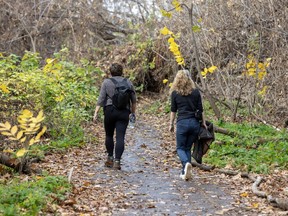Notices were sent out Tuesday to nearby residents saying access to the cliff area is prohibited for safety reasons.

The City of Montreal is telling residents to avoid a popular wooded area in Notre-Dame-de-Grâce, but people who have worked to preserve the small forest say it remains safe and the official closure is an overreaction.
Notices were sent out Tuesday to residents of the southern N.D.G. neighbourhood of St-Raymond, informing them that access to the cliff area known as Falaise St-Jacques is prohibited for safety reasons.
But people who use and maintain the paths through the narrow band of forest, which runs along an escarpment tucked between the railway tracks along Highway 20 and St-Jacques Street at the southern edge of N.D.G. say they don’t see the risk.
“I just don’t see any danger, I feel safer down here than I do up in the city, walking across the street,” said Chris Breier, a volunteer who has been maintaining the forest paths for around three years.
During an August rainstorm, there was a landslide on the far west side of the forested area, said Breier. “When we had that huge 153 millimetre rain, a big portion behind the parking lot at the Gabriel Ford collapsed.”
Breier, who said he spends about five days a week in the area, maintaining the path, clearing dead trees and otherwise keeping the Falaise safe and accessible, said he hung safety tape around the area where the landslide occurred and reported it to the city.
“I would hate to see all of my work and all of the hundreds of people that I meet on this path every week, who are getting great benefits from this path, I would just hate to see it closed completely,” he said.
The city said the notice sent to residents is a reminder that the park isn’t open to the public, city spokeswoman Camille Bégin wrote in an email.
“After the heavy rains last august, portions of the ridge detached, causing a landslide toward the green strip at the bottom of the cliff,” she said. “Following an assessment of soil stability risks, we had to restrict access to the Falaise St-Jacques in order to keep the public safe.”
Signs, intended to limit access and warn people of landslide risks, will be installed in “strategic places” within the 30-hectare area, she said.
A multi-use path, which is on the other side of a small gully at the foot of the cliff, remains open and is unaffected by the closure, she said.

The city hopes to build a larger nature park — which would include the Falaise, as well as a former train yard on the other side of the highway, she said. “The goal is to preserve the biodiversity in the Falaise and to integrate it into this large park,” she said.
No signs telling people the area was closed had been posted early Wednesday afternoon. Gates from the multi-use path that lead to a trail along the cliff were open and a popular, though unofficial, entrance to the cliff section had a sign warning of falling rocks, but no official city warnings.

Several people who walking through the area told The Gazette they were unaware that access to the cliff was prohibited.
Lisa Mintz, the executive direction of UrbaNature Education, which runs educational programs in the Falaise, said closing the area is unfair.
Few people go to the area where landslide occurred, she said in an interview, adding that a city study showed only four dangerous spots along the four kilometres of cliff.
Prohibiting access to the forest will have an impact on a lower-income area that is home to many new immigrants and members of racial minorities, she said.
“It’s unconscionable, because the people who live around the Falaise, this is their only green space, they don’t have cars, usually, they don’t have ways to get to places like this,” said Mintz.
Mintz questioned the city’s commitment to protecting the area, and said the real problem is dumping by businesses at the top of the cliff.
“They basically want us to stop doing anything in the Falaise and I don’t understand why, instead of them doing something to stop the people who are doing illegal dumping and cause this erosion, they’re putting it on us,” she said.
Breier said he too worries about dumping — business along St-Jacques plow snow to the edge of their properties, along the top of the cliff, which comes crashing down with spring rains.
The problem, he fears, is that in order to stabilize the cliff, the city would have to remove much of the forest, which has become home to a wide variety of bird species, as well as deer, foxes, squirrels and raccoons.